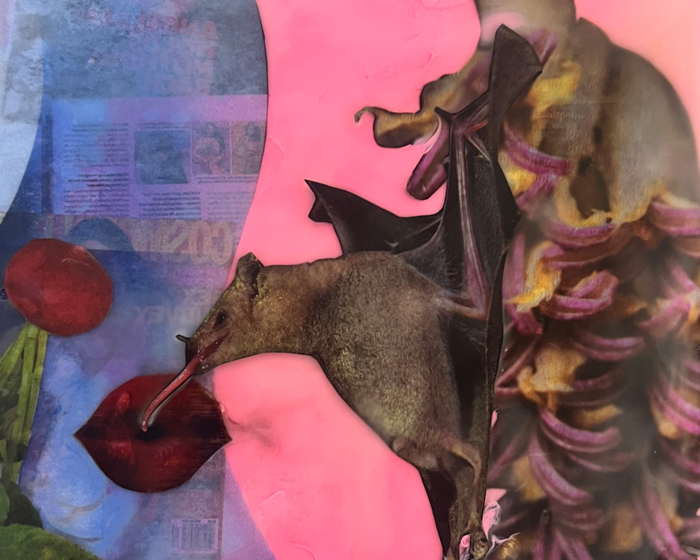
7″x7″; encaustic medium, encaustic paint, and magazine paper on board; 2023. Courtesy of the artist.
COLLAGE ON VIEW
Kait O’Brien: Taxonomy: Obligate Mutualism
at Alpaca in Albuquerque, New Mexico, USA
12 May-2 June 2023
Without pollinators, our world would look drastically different. These invertebrates, birds and mammals are critically important to the health of our ecosystems in the Southwest and across the world—but in many places their lives are threatened. Whether from loss of habitat, disease or chemical use, the decline of pollinators is the result of manmade actions that do not take accountability for the sensitive ecosystems in which we live.
Pollinators aren’t just important for food production—wax from honey bee colonies, non-foodstuff plant products and the upstream food chain cycle for indicator species in a habitat can all be traced back to these small but mighty players. And, just like the significance of pollinators extends beyond our food supply, so too does the extent of human impact extend beyond one factor, and rarely is it a good/bad dichotomy. For example, wind farms are critical to ending fossil fuel reliance and supporting the transition to clean energy—but when placed near bat migration paths, they pose a significant problem for their populations. Monocultures, some of which are important dairy animal product alternatives, can create conditions that imperil water resources and have the potential to increase pesticide use—while taking up land acreage that could be used for native plant species. How do we balance our ecological needs with our human ones? How do we recognize nuance, the grey area, and hold ourselves accountable for the health of our planet while understanding there will never be a singular solution to human-made ecological destruction?
It doesn’t have to be hopeless. While this work highlights and provides a space for grief surrounding the deep trauma our ecosystems have sustained, it also highlights the possibility of symbiosis between our human communities and our natural habitats. Kait O’Brien has been using beeswax as an artistic medium for much of her art career, and has developed a great appreciation for the medium as a versatile painting, collage and sculptural tool. As one of the oldest painting mediums, encaustic shows by its essence the deep and complex relationship humanity has with pollinators—acting as both cultivator and destructor of pollinator groups, species and habitats. Apiaries and their beekeepers offer one of the most striking examples of symbiosis—mimetic to the relationship between one of the Southwest’s most iconic pollinator relationships, that of the yucca moth (Prodoxiae tegeticula and parategeticula) have a relationship called obligate pollination mutualism with particular genii of yucca in the Southwest.,
We can learn from these examples. Our role in their communities can be either symbiotic, recognizing our obligate mutualism with our habitats or parasitic—the choice is ours to make.
(text adapted from material provided by the artist)
INFORMATION
Alpaca
Fourteenfifteen Gallery
1415 4th Street SW
Albuquerque, New Mexico 87102 USA
fourteenfifteengallery@gmail.com
Hours:
During events and by appointment (email using the address above)
